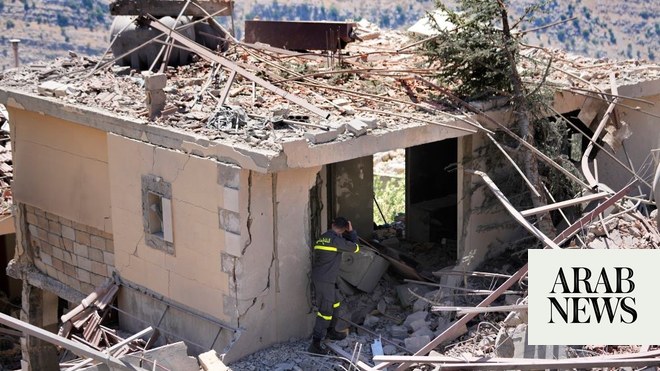GAZA STRIP: Palestinians fled eastern Gaza City on Thursday under heavy bombardment after the Israeli military ordered the evacuation of an area it had previously declared free of Hamas militants.
The outbreak of conflict in the Shujaiya district in the northern Gaza Strip, which witnesses and doctors say has caused many casualties, comes amid growing concerns about a broader regional conflict involving Israel and Lebanese Hezbollah, a Hamas ally.
Defense Minister Yoav Gallant, during a visit to Washington to discuss the Gaza crisis and ways to avoid a wider conflict in the Middle East, said Israel did not want war, but warned that massive fighting would return Lebanon “to the Stone Age.”
Fighting continues in Gaza despite comments Sunday by Israeli Prime Minister Benjamin Netanyahu that the “intense phase” of the war – now approaching its 10th month – is ending.
Officials and medics in Hamas-controlled territory said Israeli attacks overnight and early Thursday killed at least six people in the northern Gaza Strip, while the Israeli military said it had “attacked terrorists” in Khan Yunis in the south.
In Gaza City, a witness in Shujaiya, who declined to give his name, told AFP the situation was “terrifying” as Israeli military vehicles approached amid airstrikes and shelling.
“Residents are running around the streets in fear… The wounded and martyrs lie in the streets.”
Arabic-speaking military spokesman Avichay Adraee told residents and displaced Gazans in the Shujaiya area to leave “for their own safety” in a message posted on social media.
They were asked to go south to a recognized “humanitarian zone” about 25 kilometers (15 miles) away.
An AFP photographer noted that many people left the city on foot, carrying their belongings and crossing streets strewn with rubble.
Hamas in a statement said Israeli forces “launch ground assaults,” reporting “several” deaths as “thousands flee under ruthless bombardment.”
Muhammad Ghurab, a doctor at Al-Ahli Hospital in Gaza City, said the facility received seven “martyrs, including four children” and dozens of wounded “as Israeli forces advanced east from the Shujaiya neighborhood.”
Shujaiya resident Omar Sukar said he saw the strikes as Gazans collected drinking water, supplies of which were limited due to the Israeli siege.
“When the shelling started, a water truck arrived,” he told AFP.
A displaced woman in Gaza, who asked not to be named, told AFP she was “devastated” by the violence and destruction.
“We have lost our children and our homes and are still fleeing from place to place.”
Beyond the evacuation order announced by Adraee, the military declined to comment on the fighting.
The war began with an Oct. 7 Hamas attack on southern Israel that killed 1,195 people, mostly civilians, according to an AFP tally based on Israeli data.
The militants also took 251 hostages, of whom 116 remain in Gaza, although the army says 42 are dead.
According to data from the Gaza Ministry of Health, at least 37,765 people, mostly civilians, were killed in the Israeli retaliatory offensive.
Israel announced in early January that it had dismantled the “Hamas military skeleton” in northern Gaza, where the most intense fighting took place at the beginning of the war, but the militants have since regrouped.
The war and siege have created a serious humanitarian crisis. Hospitals in Gaza are struggling to function and basic supplies are hard to come by because the vast majority of the territory’s 2.4 million inhabitants have been displaced.
UNICEF announced an agreement with Israel on Thursday to restart a power line that could restore full capacity to a key desalination plant in Khan Yunis.
“This is an important milestone and we look forward to achieving it,” said Jonathan Crickx, spokesman for the UN Children’s Fund.
In a rare medical evacuation from Gaza, 21 cancer patients left hospital through the Kerem Shalom crossing on the border with Israel, a medical source in Egypt said.
It was the first evacuation since the closure of the Rafah border crossing – a key conduit for humanitarian aid to Gaza – when Israeli forces took control of the Palestinian part of the crossing in early May.
Months of talks on a ceasefire and the release of hostages have so far ended in failure as Israel has rejected Hamas demands for a permanent cessation of fighting and a complete troop withdrawal.
Israeli protesters are putting pressure on Netanyahu’s government, with thousands gathering outside Netanyahu’s Jerusalem residence on Thursday, calling for an agreement to release the hostages, according to an AFP reporter.
U.S. officials have expressed hope that a ceasefire in Gaza could also reduce hostility between Israel and Iran-backed Hezbollah, which has been shelling the border almost daily since early October.
Tensions rose when Israel said this month that its war plans were ready, prompting threats from Hezbollah that no Israel would be safe in the event of an all-out war.
Germany and Canada advised Lebanese citizens to leave the country.
During Thursday’s latest clashes, Hezbollah said it fired rockets at an Israeli military base and sent drones in retaliation for Israeli attacks on Lebanon, one of which killed a militant.
Israel said its air defenses “intercepted most of the launches,” reporting no casualties.
Meanwhile, Israel rejected a UN-backed report that found nearly half a million Gazans faced a “catastrophic” famine.
Government spokesman David Mencer said the “starvation claims” were aimed at “putting pressure on Israel.”

